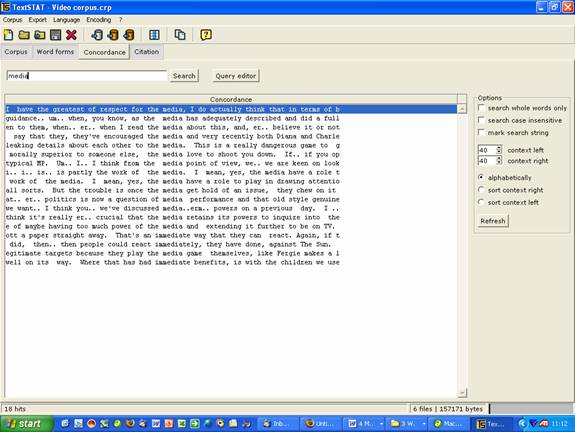
A Brief Introduction to Corpora and the Lingonet Video Corpus
Dr Mike Nelson
1. Corpora: what are they and where did
they come from?
What is a corpus ?
The term
corpus
(plural corpora) comes from the Latin word meaning
body. Thus, in the case of language, we are talking about a body
of language - a collection, usually computer-stored, of language which can then
be used for analysis.
How did corpora begin and develop ?
Corpus linguistics - using corpora to study language, has had a
somewhat chequered history in the world of language research. Its origins can be
traced back mainly to the 19th century (though analysis of Shakespearean texts
was undertaken already 400 years ago) and the image of silver-haired
professors straining over mountains of text and manually counting occurrences of
linguistic features, has been a hard one to dispel. Have a look here for more
information about the history of corpora.
http://www.ling.lancs.ac.uk/monkey/ihe/linguistics/corpus1/1fra1.htm
The field was, however, held in some regard until an
infamous attack on its basic premises by Chomsky.
In a number of articles in the late 1950s and
1960s, Chomsky challenged the whole notion of empiricism on which corpus
linguistics was based and suggested instead a rationalist approach. As Chomsky
was more interested in competence than performance, corpus linguistics, which
was primarily based on actual performance seemed to be invalidated overnight. It
led to a situation that Sinclair describes:
Starved of adequate data, linguistics languished - indeed
it became almost totally introverted. It became fashionable to look inwards to
the mind rather than outwards to society. Intuition was the key, and the
similarity of language structure to various formal models was emphasized.
Sinclair (1991:3)
Work on corpora continued despite these criticisms and, with the
advent of the computer, really came into their own. The work begun in the early
sixties by Randolph Quirk (the SEU Corpus), and Francis and Kucera (The Brown
Corpus) was capitalised on by Svartvik in creating the London-Lund Corpus (LLC),
creating a machine readable corpus of spoken language for the first time. By the
1980s corpus linguistics had almost found its way back into mainstream applied
linguistics. This rise of corpus-based research can be seen in the number of
corpora created. Svartvik (1992:8) shows that only ten were created before 1965,
but between 1986 and 1992, 320 have been created. It is safe to say that
most recent work on the large scale has been concerned with dictionary creation,
and as teachers we are all aware of, for example, the COBUILD project, and
perhaps also the British National Corpus (BNC) which has been developed by
Oxford University Press, Longman and Chambers. Corpora are back in
vogue.
2. Key terminology
In this section
we will look at two of the key concepts used with corpora.
2.1 Concordancing
Concordancing is the act
of picking out examples of a given word in context. The software used for doing
this are often called KWIC concordancers (Key Words In Context). Thus, for
example if we are interested in the word “dog” the concordancing program would
search out all examples of the word and place them in rows with the word “dog”
in the middle. Have a look below to give you some idea of what a concordance
line looks like, using the word ‘media’ taken from the Video Corpus.

2.2 Collocation
There are many definitions
for what collocation is, but basically it refers to how words co-occur. Thus the
word blonde co-occurs almost always with the word hair. They
are thus said to collocate. Collocations can be strong e.g. vested
interest or weak e.g. brown hair. For more on this look now at these
collocations taken from a business English corpus of words that collocate with
the word market.
stock market, market share, single market, mass
market
market leader, market driven, market segment
In order to do concordancing, first of all you need both a
corpus, a computer and some kind of software to run it. There are several
commercial packages available for looking at corpora and concordancing, but this
package uses TextSTAT:
http://www.niederlandistik.fu-berlin.de/textstat/software-en.html
3. Using Corpora : in research and in the
classroom
Murison-Bowie (1996:182) in an article entitled
Linguistic Corpora and Language Teaching notes that over the last
few years there have been two opposing views of using corpora in research and
language teaching:
The Strong View says that without a
relevant corpus no meaningful work can be done.
The Weak
View states that corpora give us a valuable insight into language and
how it works and this is something we can draw on in our teaching.
Which side do you come down on? Perhaps the safest way is to stick to the weaker side. For example, much corpus work hinges on the concept of frequency. The theory goes that the more frequent a word is, the more important it is to teach it to students. However, the most frequent word in English is “the” and whilst it is no doubt important to make sure our students can master the article system , it doesn’t get them very far in other ways. Remember the complaints of Chomsky discussed earlier? He dismissed frequency by saying it was of no importance at all and he gave this example:
“I live in Dayton, Ohio.”
“I live in New York”
In the English language the first sentence will always be
less frequent than the second, thus the data in any corpus would be naturally
skewed and therefore useless. Michael Lewis in his talk at the 1998 IATEFL
conference when launching LTP’s new collocational dictionary suggested a
sensible middle-ground. Use a corpus - but also use your common sense and
intuition. Corpora can and have been used to give us great insights into the
language. What follows are a few examples I have come across in my own
research.
Research
Holmes (1988) made a study of how the concepts of doubt and certainty are presented in ESL textbooks. She, herself, advocated the use of small corpora and used a combination of two corpora to compare findings to an examination of four well known textbooks. Her results showed that whilst in some cases, doubt and certainty - were adequately covered, “some textbooks were positively misleading” (Holmes 1988:40). She noted that other books give information of “variable quality” (1988:40). Interestingly, she also dismisses earlier attempts of analysis of this issue on the grounds that the research had not been corpus based, but along rationalist lines.
In another study, Kennedy (1987) looked at quantification, more
specifically the use of approximation, and how it is used by native speakers.
Two corpora and the Oxford Concise Dictionary were consulted and compared to
input from teachers who were asked to give their own intuitive input on the
subject. The results showed that the intuition of the teachers gave the largest
range of types of approximation terms, but that on its own it was not enough.
The vast amount of intuitive information needed ordering and:
the frequency data which the computer-based examination of
these types in large corpora now makes possible were also necessary to give the
descriptive information pedagogical value.
Kennedy (1987:282)
Flowerdew (1991) compared biology lecture notes to the COBUILD corpus and to published material and found several differences, for example, the use of the word then.
Ma, (1993) studied the difference between a corpus of 50 business letters and published materials for its teaching and also noted several differences, for example, use of the PS section of letters was not covered in the materials, but widely used in real life.
Pickard (1992) noted that the language of refutation used in textbooks was not actually used in real life.
Ljung (1990), in “A Study of TEFL Vocabulary” created a corpus of TEFL textbooks used in Swedish schools and compared it to several corpora, notably COBUILD. He found great discrepancies between “real” vocabulary and the materials used for teaching it. A frequency count showed that 204 words out of the top 1,000 were not shared by the two corpora showing a significant difference in emphasis, especially between concentration on concrete terms in the EFL corpus to more abstract terms in COBUILD. In his conclusion, he notes that:
there is reason to be critical of the TEFL texts on two major
counts, i.e. the low general level of lexical sophistication and the absence of
a clear increase in vocabulary difficulty as we move from the early to the later
school years.
Ljung (1990:44-45)
He goes on to note that the materials do not adequately prepare
the students for the tasks of the real world.
Thus, it can be seen
from these studies that corpus-based examination can be a very useful exercise.
In each of the examples we find that the text books to some extent had got it
wrong. Thus if text books are all flawed what should we do ? This leads us very
nicely to the next section where we can look at actual corpora and see what we
can do with them in the classroom.
4. The
Classroom
So what can you do in the classroom with a
corpus? There are several things that can be done very easily:
4.1 Looking at Frequency This is the most simple and most corpus analysis tools will give you the frequency lists of texts. This is perhaps not very interesting, but it can show - apart from all the grammar and function words - which special words, for example, in a given genre are the most frequent. Thus you could feed in the language found in this Video Corpus and compare it to a general English corpus.
Here we see the frequency list of the Video Corpus:
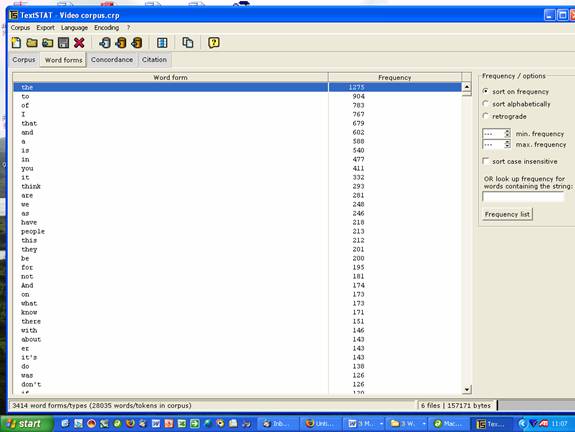
4.2 Looking at Collocations The fact that computers can generate such a large amount of collocations in seconds affords the teacher and student access to very interesting and relevant information. For example, a business English student wants to know more about how the word market is used. The word can be keyed in and the collocates examined. In this way new collocates and even idiomatic phrases can be seen in context and learned. Have a look at Michael Lewis’s book Implementing the Lexical Approach for a much more detailed account of how this can be done.
Here we can see collocates of the word 'monarchy' taken from the Video Corpus.
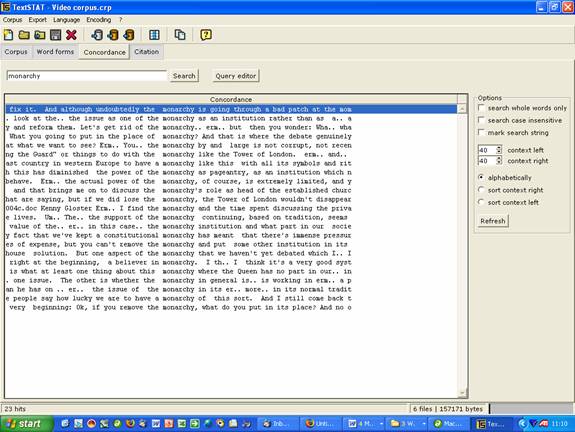
4.3 Looking at Words in context: Concordance
lines can give you not only the words immediately around a key word but you can
also see the word or form you are looking at in larger context.
4.4 Looking at Test design - using gap-fill
corpus-based
Butler, 1991, used a concordancer to help design
tests. He searched out key words in context using a corpus and the test process
then became one of choice for the teacher - choosing from items presented -
rather than just sitting down and thinking what would be good examples to test
the items.
4.5 Getting students to see grammatical patterns:
For more advanced students you can use a corpus for them to
see how certain grammatical patterns are used in real speech/writing. In 1988,
Johns use a corpus to get his students to look at the differences when the word
“to” is used as an infinitive and when it is used as a preposition. He also
asked them to look at how the words “therefore” and “hence” differentiated in
their use.
Why not try stating with something very simple, e.g. examining the difference between “make” and “do” by looking at which words collocate with them.
Concordance line of 'make' taken from the Video Corpus:
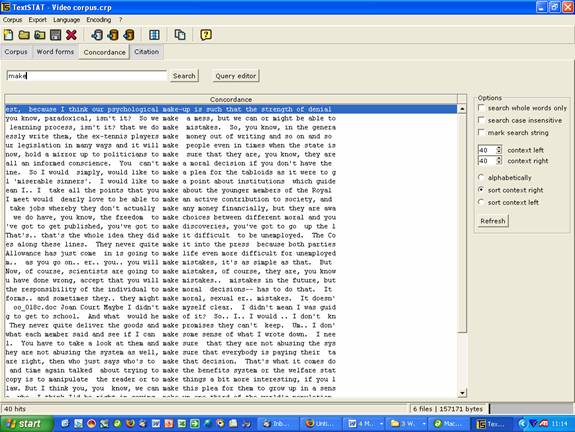
Concordance line of 'do' taken from the Video Corpus:
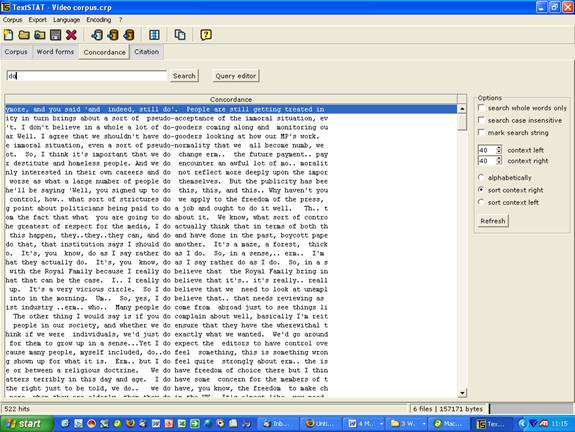
5. Exercise types you can easily
develop from the Video Corpus
This next section will show you a few exercise types that are
very easy to make once you have a corpus to work from.
5.1 Working with collocates -
before or after the keyword ?
In this kind of exercise you can use a
corpus to generate collocates of given key word. Then, mix them up and ask the
students to decide if the words come before or after the key word. This helps
with familiarity and meaning can be discussed in the lesson.
5.2 Fill in the gaps
The old standard
gap-fill type exercises are much better when you can take them directly from an
authentic corpus - just remove collocates or key words and get the
students to fill them back in again.
5.3 Linking
sentences
Again, another very simple old
exercise. Take sentences from the corpus and split the sentences in half. Then
ask the students to put them back together again.
6. Beyond the silent corpus
The big advantage that is to be gained from using the Video Corpus is the fact that the text 'comes to life' and all the texts that are available for concordancing and analysis can be watched and listened to in the precise manner in which the language was originally used. The sound and vision also offer new possibilities for the classroom.
6.1 Listening for linguistic devices
The possibility for listening can help in exercises based around certain linguistic devices, for example, hesitating devices found in the text below. Further use of fillers and false starts can also be analysed.
Right. Um.. Yes, of course, I do think we
need a welfare state um.. in order to
accommodate the needs
of the weaker members of our society. It's absolutely
essential.
Um.. And Britain was really at the forefront in.. in
setting up its welfare
state in the middle of the century.
Um.. And I think that's something we should be
very proud
of. What is rather sad I think is that a lot of people are now feeling as
though they've been conned, um.. particularly elderly
people who have erm.. paid their
national insurance stamps
for many many years, expecting to be cared for, in their,
when they become older.
6.2 Video for discussion
As the students are able to see and listen to all the texts in the corpus they can be used as preparatory material for group discussions. Individual students can separately watch the opinions given by different members of the panel and then elaborate on their arguments for their own debates on the issues as part of group discussions.
6.3 Video for presentations
In the same manner, students can use the information gained from the corpus and the opinions given to prepare their own presentations on the same topics.
6.4 Video for pronunciation, word stress and inflection
The texts in their audio-visual form can be used to study the pronunciation of words and the word stress and inflections used.
6.5 Video for body language
The video can be used for the study of body language in relation to speech: is there specific body language attached to certain words/ideas?
7. Conclusions
In this short article we have seen that
despite the arguments against corpora, it can be argued that they are an
effective method for both research and for organising exercises for the
classroom. The argument over the sufficiency of the concept of frequency over
the intuition of native speakers will continue to rage. The middle ground,
however, can be taken - use a corpus to get the data and then use your
intuition on how to get the best out of it.
Gathering, collecting and
organising a corpus of your own is a time consuming and often boring process.
The Video Corpus provides you with a small but useful body of language to
utilise in the classroom. You can thus have instant access to authentic,
relevant and hopefully motivating language.
8. Background reading
There is a marvellous full on-line course on corpus linguistics at Lancaster University http://www.ling.lancs.ac.uk/monkey/ihe/linguistics/contents.htmcreated by Tony McEnery and Andrew Wilson. Please have a look through- even if you don’t want to do it all.
Note that they have a full section on Corpora in language teaching at: http://www.ling.lancs.ac.uk/monkey/ihe/linguistics/corpus4/4fra1.htm
See David Lee's great site on everything related to corpora Devoted to Corpora
and Bibliography
Butler, J. (1991) Cloze procedures and concordances:
the advantages of discourse level authenticity in testing expectancy
grammar in System 19 (1/2), 29-38
Flowerdew, J. (1991)
Corpus-Based Course Design in Milton, J.C. and Tong, K. (eds) Text Analysis
in Computer Assisted Language Learning, 31-43. Hong Kong: The Hong Kong
University of Science and Technology and the City Polytechnic of Hong
Kong
Johns, T. (1988) Whence and Whither Classroom
Concordancing ? in Bongaerts, T. et al. (eds) Computer Applications in
Language Learning. Dordrecht: Foris
Kennedy, G, D.
(1987) Quantification and Use of English: A Case Study of One Aspect of
the Learner’s Task in Applied Linguistics Vol 8 No. 3 Oxford: Oxford
University Press
Lewis, M. (1993) The Lexical
Approach Hove: LTP
Ljung, M. (1990) A Study of TEFL
Vocabulary Almqvist and Wiksell International: Stockholm,
Sweden
Ma, K.C. (1993) Text Analysis of Direct Mail Sales
Letters in Boswood, T., Hoffman, R. and Tung, P (eds) Perspectives on English
for Professional Communication Hong Kong: City Polytechnic of Hong
Kong
McEnery, T. and Wilson, A. (1996) Corpus Linguistics
Edinburgh: Edinburgh University Press
Murison-Bowie, S.
(1996) Linguistic Corpora and Language Teaching in Annual Review
of Applied Linguistics 16, 182-99: Cambridge: Cambridge University
Press
Pickard, V. (1991) Should We Be teaching Refutation ?
Concordanced Evidence From the Field of Applied Linguistics Paper
presented at the Eighth ILE International Conference 15-18 December,
1992
Sinclair, J. (1991) Corpus, Concordance, Collocation
Oxford: Oxford University Press